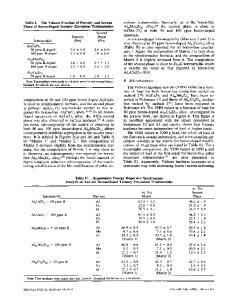Lanthanide Doped Cubic Boron Nitride
- PDF / 113,833 Bytes
- 6 Pages / 612 x 792 pts (letter) Page_size
- 70 Downloads / 396 Views
M8.38.1
Lanthanide Doped Cubic Boron Nitride U. Vetter1, T. Taniguchi2, U. Wahl3, J. Correia4, A. Müller1, C. Ronning1, H.Hofsäss1, M. Dietrich4 and the ISOLDE Collaboration4 1 2. Physikalisches Institut, Universität Göttingen, Bunsenstr. 7-9, D-37073 Göttingen, Germany 2 National Institute for Research in Inorganic Materials, 1-1 Namiki, Tsukuba, Ibaraki 305-0044, Japan 3 Instituto Tecnologico e Nuclear, PT-2686-953 Sacavem, Portugal 4 CERN, 1211 Geneva 23, Switzerland
ABSTRACT First basic investigations on lanthanide implanted cubic boron nitride were performed with focus on the site of the implanted ions as well as their luminescence behaviour. In order to investigate the lattice sites of lanthanides in c-BN, we implanted single crystal c-BN with radioactive 139Ce ions using the on-line isotope separator ISOLDE at CERN. After the samples were annealed at 1193 K, direct lattice location studies were performed using the conversion electron emission channeling technique and showed a near-substitutional fraction of the implanted ions of at least 10 %. Additionally, poly crystalline c-BN samples were implanted with stable Eu and Tm ions in order to investigate the luminescence properties of triply ionised lanthanides in the c-BN host. It is found that the annealing of the implanted samples at high temperature and high pressure results in strong luminescence of the Eu3+ ions in the orange and moderate luminescence of the Tm3+ ions in the blue. In case of the Eu implanted samples, the luminescence is assigned to the 5D0-7FJ intra-4f electron transitions of Eu3+, in case of the Tm implanted samples, detectable transitions are 1D2-3H6, 1D2-3F4,1G4-3H6. of Tm3+.
INTRODUCTION The III-V semiconductor cubic boron nitride (c-BN) shows many extreme physical properties, as regards its chemical resistivity and diamond-like hardness, the very large band gap of 6.1 - 6.4 eV [1] and its reduced ionicity [2]. As extreme as its physical properties are, are the conditions under which c-BN can be synthesized. The growth of layers of c-BN on substrates is bound to the use of energetic ions and the thin films obtained in such a way are nano crystalline. Among the growth methods applied, mass selected ion beam deposition (MSIBD) [3] is a very attractive approach for the synthesis of pure c-BN films under UHV conditions. Doping these films with lanthanides during growth, which was recently demonstrated for c-BN:Eu (0.1 %) [4], is one possible approach to synthesize lanthanide doped c-BN. The main problem is the extreme chemical reactivity of Eu, and even under UHV conditions oxygen incorporation is visible. Doping such thin films by ion implantation is not useful, because the films are not sufficient thermally stable to allow an annealing of the implantation defects. An alternative of doping c-BN with lanthanides is the ion implantation into poly or single crystalline c-BN. In recent years tremendous progress has been made to synthesize single crystalline [5] and pure poly crystalline c-BN [6] under high pressure and high temperature con
Data Loading...










